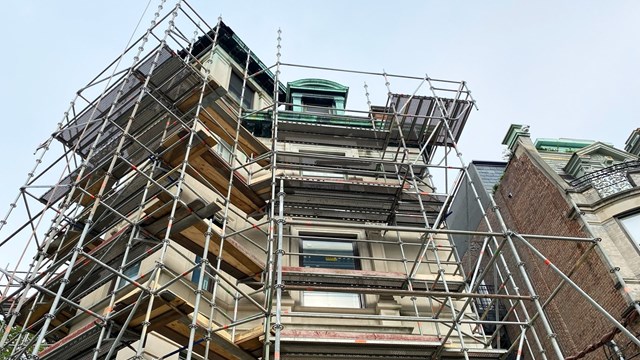Today, almost all residents of co-op and condo buildings are computer-knowledgeable. They can tell you how many ports your PC has, how many gigabytes are in the hard drive, how to set up a printer, and more.
When it comes to electric wiring, however, the situation changes. Although apartment owners usually know where the circuit breakers are located or how to put in a power strip, electricity is a mystery to most people beyond that.
And little wonder. Electricity can be dangerous—ask anyone who’s had an electric shock (even a small one, as this writer once had when he foolishly tried to tighten a socket in a wall lamp with a pair of pliers when the lamp was still plugged in). That’s why there are many, many amateur computer professionals, but few amateur electricians. So, when it comes to troubleshooting electrical problems, it’s best to call in a licensed professional electrician or electrical contractor.
Old Buildings, Older Wires
In New York City, even though some buildings are over 100 years old, the average age of multi-family residential electrical systems is about 20 years old, according to Eli Nathan of Citiwide Communications in the Bronx, which does intercoms, roof alarms and card access systems as well as electrical wiring.
At one time, adds Emily Ettinger-Kron of Ettinger Engineering Associates in Manhattan, buildings in New York utilized direct current (DC). Beginning in the 1930s or thereabouts, residential building design in the city was changed to alternating current (AC). By now, with the exception of some elevators, almost all residential buildings have been changed over to AC.
From time to time, buildings’ owners or management are forced to upgrade the wiring system because of changes in technology—a heavier load, for example, or the need for more and more outlets. Indeed, says Nathan, the most common electrical system problem in the city is “lack of adequate power for the building.”
New York City has an electrical code that governs all electrical systems (it’s actually a national code, but enforcement is done by the New York City Department of Buildings—but more on that later). It specifies that electrical work should be performed by a licensed electrician.
Indeed, the regulations are very strict. “Everything is governed, from the type of wire used, to how it is run,” says Nathan. “Everything must be filed with the New York City Bureau of Electrical [Control], and everything is inspected by a city inspector.”
In 2003, New York City adopted the National Electric Code, although the city has instituted amendments and interpretations since. The code originates with the Boston-based National Fire Protection Association (NFPA). Jeff Sargent, NFPA senior electrical specialist, recently told The Cooperator about some of the warning signs of electrical problems.
What to Look Out For
For example, Sargent says, if residents hear a crackling sound when they turn on a switch, it may indicate a poor switch connection. And a connection or plug that’s very warm or hot to the touch indicates a loose connection or overheated condition.
As most co-op and condo residents know, a circuit breaker that “trips,” or shuts down, indicates that one may have an overloaded circuit. However, that’s only the best-case scenario. “If the circuit breaker trips immediately, it means there’s a more severe problem, a short circuit,” Sargent adds.
Other warning signs of electrical problems can include frayed wires, frequent loss of power, and flickering or dimming of lights. “Dimming the lights” is often thought of as a prelude to romance—but not if it comes unexpectedly and involuntarily.
“If you notice a kind of burning or hot smell around electrical equipment, that may also indicate that something is wrong,” continues Sargent.
The Bottom Line
If these problems are ignored, it could be bode ill for your building’s bottom line, since most electrical problems are urgent and result in emergency fees to the contractor, and require immediate attention—even if the building is short on funds.
Ettinger-Kron points out several other factors that could affect the bottom line, especially in new design:
• The efficiency of lighting and lighting controls.
• The efficiency of motors.
• The time of day for usage and the amount of daylight available.
• Limiting “light pollution,” or loss of light from the building or site.
To elaborate, small improvements in motor efficiency can generate significant savings in energy costs, since electric motors typically consume many times their original costs in electricity every year. And lighting controls such as dimmers and occupancy sensors can also save energy costs, by turning lights off when they aren’t needed. We recently saw, in a Downtown Brooklyn co-op, a stairwell where the lights came on only when somebody entered the stairs.
Be the Watchdogs
What should your maintenance staff do? Clearly, they shouldn’t try to fiddle with the building’s internal wiring on their own. Electrical systems, according to Nathan, “should only be maintained by a licensed electrician—not only because this is required by New York City law, but also because an improper connection is a fire hazard.” Everyone has heard stories of a short circuit resulting in a fire that destroys a building—or worse, costs lives.
One thing building staff can do, says Sargent, is “to be the observers and the watchdogs for some of the items we talked about. If they notice or see or hear of any or those problems, they should notify management so a qualified person can investigate.”
Ettinger-Kron says that building staff can also periodically check fusing, test generators and fire alarm systems, and avoid overloading circuits, as well as cutting off cracked insulation at wire ends and taping properly.
Thankfully, there are resources on the web to help qualified professionals. The city’s building department has material on the electrical code on its website (nyc.gov/html/dob/html/model/nec.shtml).
And the NFPA, on its own website (www.nfpa.org), posts two documents: NRPA 70B, “Recommended Practice for Electrical Equipment Maintenance”—
which Sargent says applies to the individual dwelling units—as well as NFPA 73, “Electrical Inspection Code for Existing Dwellings.” Sargent says the second document “can be used as a tool for developing a maintenance program for the overall electrical distribution systems supplying the multiple individual dwelling units.”
Testing and Maintenance
How often should electrical systems be assessed and/or tested for efficiency and safety?
Those interviewed for this article gave several answers. Nathan says, “biannually is adequate.” Ettinger-Kron says, “That would depend on the age of the system. For newer and moderately old systems, a five-year routine might be adequate. For an older system, this could be reduced to two years. It is better to proceed with more caution than less.”
Barbara Holland, president of H&L Realty and Management Co. in Las Vegas, an active member of the Institute of Real Estate Management, feels there should be an annual inspection of service panels, circuit breakers, receptacles (or outlets for plugs), and all connections.
Annual maintenance, she adds, should consist of tightening loose connections in service panels, replace any loose, warm or weak-feeling circuit breakers, and replacing all receptacles that don’t hold cords tightly or show signs of damage.
The way an electrical engineer tests and/or assesses a building’s wiring, says Nathan, is “visually and by calculating the load requirements of the building versus the actual load capacity.”
Sargent mentions both visual testing and infrared scanning to determine “hot spots” within major components. And Ettinger-Kron mentions several types of tests: short circuits test, ground fault test, arcing test, checking wires at connection points, and checking and torquing lugs at the switchboard. (In case you think we’re beginning to speak a different language here, the American Heritage dictionary defines torquing as “applying a turning or twisting force” and a lug as “a copper or brass fitting to which electrical wires can be soldered or otherwise connected.”)
How much does all this electrical testing cost?
“Time and cost needed for inspection will vary on the size of the property and thoroughness of inspection,” says Holland. “A general inspection of a percentage of random units is usually adequate to assess whether a complete inspection of the property is warranted.”
“Cost is a function of time,” says Ettinger-Kron, whose family firm does HVAC, plumbing and fire protection consulting as well as electrical. “An average [apartment] building could be tested in two to three days.”
What Apartment Owners Can Do
What preventive maintenance can individual apartment owners do to prevent electrical problems or fires in their apartments?
One thing you can do is to make sure cords are in good condition, not frayed or cracked.
You can also check for outlets that have loose-fitting plugs, which can overheat and lead to fire. Any missing or broken wall plates for on-off switches should also be replaced.
Space heaters should be kept a reasonable distance away from combustible materials such as bedding, clothing or rugs, even though today’s electric heaters are miles ahead of the old-style gas or oil heater in safety. Unplug them when they’re not in use. Also, don’t plug it into an extension cord—plug them directly into the outlet.
Don’t place a halogen floor lamp, which can produce a very great level of heat, in an area where it could come into contact with draperies or clothing. That’s what happened to the late jazz great Lionel Hampton’s apartment, and although, thankfully, he was spared, much of his valuable memorabilia was gone forever.
If a particular appliance continuously trips a fuse or forces a circuit breaker to turn off, maybe it’s best to have that particular appliance looked at or repaired.
Obviously, don’t plug too many appliances into an extension cord. The invention of the modern power strip has done much to curb this once-common problem.
While a great deal of dealing safely with electricity has to do with exercising common sense and a reasonable level of caution, it’s always important to remember that beyond the most basic trouble-shooting and accident prevention, it’s best to leave repairs and maintenance to the professionals.
Raanan Geberer is a freelance writer living in New York City.







Leave a Comment